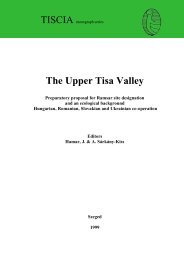full text - biokemia.bio.u-szeged.hu
full text - biokemia.bio.u-szeged.hu
full text - biokemia.bio.u-szeged.hu
Create successful ePaper yourself
Turn your PDF publications into a flip-book with our unique Google optimized e-Paper software.
of other species, too: Abramis brama, Cyprinus earpio, Stizostedion lucioperea,<br />
etc. These changes can mostly be seen from the results of the probe fishings (Table 1)<br />
and from the total catching data for the more important species, respectively (Fig. 3).<br />
Data on species of small meaSures - e.g. Alburnus alburnus, Rutilus rutilus, etc. -<br />
were mainly obtained during the course of our fishings with l cm mesh square fishingnets.<br />
Where marsh~ like living places developed at the storage area, the earIier repressed<br />
stagnophyl species also started to increase: Tinea tinea, Carassius earassius, Misgurnus<br />
fossilis, however, their stock is still not significant.<br />
On the basis of the changes taking place in the fish stock, it could be determined<br />
that the studied section of the Tisza river no longer belongs to the upper part of the<br />
carp-region, but to the lower, and this should be taken into consideration regarding<br />
the fish economy interventions.<br />
Problems related to fish economy<br />
Approximate picture of the fish amount caught from the water basin could be<br />
forrned on the basis of the catching registers kept by the anglers and the statistics<br />
of the fishery co-operative functioning at the water area. It can be seen from Fig. 2.<br />
that the caught amount of fish significantly increased foIlowing the embankment of<br />
the storage area.<br />
The carp found fa vourable conditions at the storage tank, and its catching showed<br />
steady increase (Fig. 3B). The experiences of the labeIlings perforrned in 1972 provided<br />
basis for their growth and migration. The labeIled fish averagely weighing<br />
400 g were set out in Apríl, and by the beginning of August in the following year they<br />
reached an average body mass of 2040 g, and several individuals weighing around<br />
4 kg were found in the Summer of 1974 (HARKA 1975).<br />
The number of carps staying at the reach where they were introduced could be<br />
conc1uded on the basis of the individuals found at the area one year after labelling.<br />
Two-thirds ofthese originated from the water fiows belonging to the area ofthe water<br />
basin. The farthest notifications proved the covering of about a 100 km long path<br />
both up and down the river. Nevertheless, this labelling was perforrned befo re the<br />
barrage was set int o operation, therefore it cannot be regarded as authentic in respect<br />
to the present situation, however, the newer labeIIings have not yet provided<br />
evaluable results.<br />
The banking up of the storage-tank was als o favourable for the pike-perch.<br />
Although the species could be found in unchanged amount at the bed, its catching<br />
greatly increased at the storage area (Fig. 3C). Studies on the development of this<br />
species were carried out at the time when only the bed's banking up was being perforrned<br />
at the reach (HARKA 1977). In that period the growth rate of the pike-perch<br />
from the Tisza river surpassed that of the slowly growing stock from Lake Balaton<br />
(BÍRÓ 1970), but as a matter of fact it appeared to be rather moderate. Since the<br />
banking up of the storage tank, however, the experiences have manifested considerable<br />
improvement of their condition, as weIl as their faster growth. The newer studies<br />
on growth should determine the degree of changes. It is worth mentioning in connection<br />
with the results of pike-perch hauls (Fig. 3C) that these also inc1ude the data<br />
of the Stizostedion volgensis, which come to about 5 % of the who le.<br />
The annual amounts of hauls regarding the pike were in general characterized<br />
by large fiuctuations, and this characteristic feature could als o be followed from the<br />
data gained duríng the course of the past decade (Fig. 3A). In the years following the<br />
123










